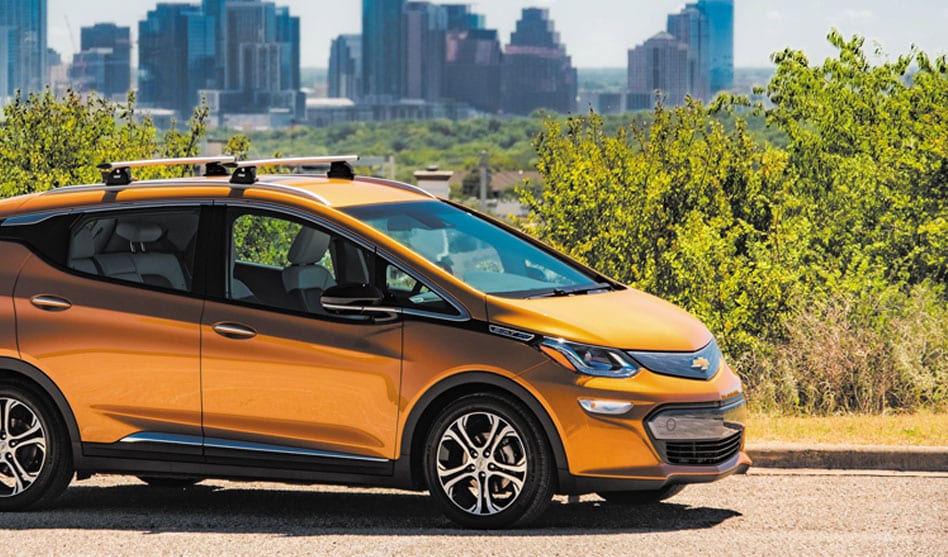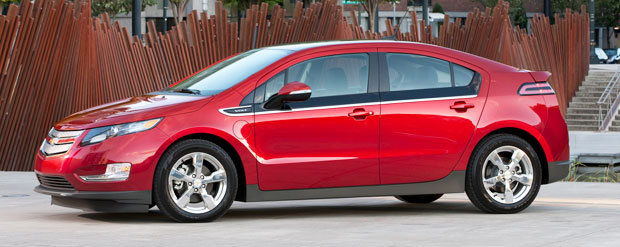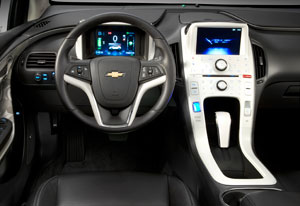The Chevy Volt hybrid boasts green technology, but it’s also a blast to drive
CASEY WILLIAMS | Auto Reviewer
crwauto@aol.com
After running errands one night, I drove my Chevrolet Volt electric car into my garage, plugged its charger into a standard outlet, connected the other end to a receptor on the side of the car and went inside for the night. According to the dash read-out, it would be fully charged before my first cup of coffee. Then, my mother texted me and invited me to lunch at their house — 50 miles away.
“If I go lightly on the throttle,” I think, “the Volt just might make it.”
I rarely go lightly on throttles and didn’t this morning, either. I rode gently through the Starbucks drive-through, but after that, I made myself giddy accelerating with whooshing abandon and
cruising along at 70 mph.
Exactly 41 miles into my amusement, the battery pooped out. And I didn’t care. The car changed its display screen priority from battery range to a gas gauge, woke the 1.4 liter, four-cylinder engine, and kept whirring along. When other electric cars, including The Holy Tesla, run out of power, you walk or call for a flat bed. I click to Elvis Radio and enjoy a sunny drive. Welcome to the future.
Anybody of my generation who drives the Volt will instantly transport themselves to the ‘80s and the movie Back to the Future. In case you’ve lost track of time, the DeLorean is now as old as the ‘50s cars were then; we’re only four years from the future depicted in Part II. Wall-sized televisions have come, we can video chat anywhere and libraries are obsolete. If you could have told Marty McFly about the Internet, iPads, or this car, his head would have spun off. Volt looks the part of a sci-fi star.
No other General Motors product spent more time in a wind tunnel than the Volt, which explains its perfectly honed, streamlined shape. It may not be as sexy as the original 2007 concept car, but it is much roomier, persuades wind with Chevy’s trademark crossbar grille, looks sharp in its creases, rolls on 17-in. polished alloy wheels, and pays homage to the original concept with a black strip under the windows.
A front splitter, spoiler on the hatch, and motorized grille shutters divert air with a minimum of drag — all important when attempting to inch up electric range. Some call it ugly, but I think it is handsome.
 On a continuum from pure electric vehicles like the ‘90s GM EV1 and Nissan Leaf to full gasoline models like the Corvette is a wide middle band. A Toyota Prius is towards the ‘Vette side since it is a gas vehicle, assisted by batteries. The Volt is on the other half of the middle: An electric car, backed by gasoline.
On a continuum from pure electric vehicles like the ‘90s GM EV1 and Nissan Leaf to full gasoline models like the Corvette is a wide middle band. A Toyota Prius is towards the ‘Vette side since it is a gas vehicle, assisted by batteries. The Volt is on the other half of the middle: An electric car, backed by gasoline.
Charging the Volt’s lithium ion batteries is easy. Connect the included charger to a standard outlet, open the little portal near the driver’s door by key fob or door release, plug in, and wait about 10 hours. Or install a 240v charger and cut it to four hours. (The cost per charge is about $1.50.) Regenerative per-charge brakes put some juice back into the batteries during deceleration. Chevrolet claims an all-electric range of 35 to 50 miles, but total range including gas is about 380 miles — very sizeable.
In 100-degree Texas heat with and the A/C running at full blast constantly, expect less battery range. The EPA rates the Volt 93-MPGe on electricity and 37-MPG on gasoline. Expect 60-MPG on average and low-40s, burning fossils on the highway.
That’s all cool and stuff, but I’d buy a Volt just for the driving experience. Step on the forward motion activation pedal and the car accelerates eerily smoothly, with ample torque and no gear shifts, up to 100 mph. A Sport mode makes the throttle more responsive, but eats power. Outside of tire noise and faint motor whine, the car is silent. Even with the gas engine running, there is only a distant rumble from under the hood. Since the engine powers the electric system and virtually never drives the car directly, Volt remains an electric car. Steering feel is near perfect, the chassis likes to play, and the car feels tomb solid with its 3,781 lbs. of weight. It makes some big name hybrids feel like science projects by comparison.
I couldn’t resist blasting “Power of Love” by Huey Lewis and the News through the Bose audio system. Beyond sweet sounds, Volts come with options like heated leather seats, USB input for iPods, Bluetooth phone connectivity, automatic climate control, and front knee airbags. Navigation, audio, and climate are adjusted through a touch-sensitive center control panel. LCD screens display audio/NAV, MPH and a summary of energy usage during trips. It sounds complicated, but is as easy to use as an iPad.
Fold down rear seats and a big hatch makes it more practical than the Chevy Cruze with which it shares a basic architecture. A rear center console was necessitated by the battery pack, limiting passengers to four.
About 75 percent of us travel less than 40 miles per day, and in the Volt, we would never burn gasoline. However, if you want to drive to California, or just your parents’, fill up and go! Perhaps best of all, the Volt drives not like some cobbled-together prototype, but a fully-developed, completely-realized version of the future. This car is real, and it is a delight. To my dreadful sadness, the Volt has gone home and I am back from the future. But I know driving has forever changed.
Prices start under $35,000 after a $7,500 federal credit and include an 8-year/100,000-mile battery warranty. (Prius PLUS Performance Package, available on the Volt, is the first wave of PLUS-branded upgrades coming from Toyota in the coming months. Through relatively simple enhancements, drivers concerned about efficiency and ecology can also have a lot of fun driving their green rides. The PLUS package is priced at $3,699 for Prius Two, Three and Four models and $2,999 for Prius Five.)
This article appeared in the Dallas Voice print edition July 22, 2011.



















Thank you for a very well written article. I decided to order a Volt after calculating that it would cost me about $5/month more than my current vehicle, a 2008 Impala. Here is all of the math:
https://bobbleheadguru.com
Fun to drive was not factored into my calculations… perhaps I need to adjust the numbers? or maybe, I save the “sport mode” for the weekends.
I got over 150 MPG in my Volt last month without compromising my lifestyle. That’s for 1250 miles of combined city and highway commuting.
The Volt is my first American car. This car is very fun to drive and in my opinion handles as well as a BMW 3 (in the same price range). The quiet ride and acceleration in Sport Mode is remarkable! Safety was a big draw for me as it has the highest safety ratings and 8 airbags. The car is very solid, the seats very comfortable even on 1000 mile drives. I’d prefer knobs to touch controls, but no car is perfect.